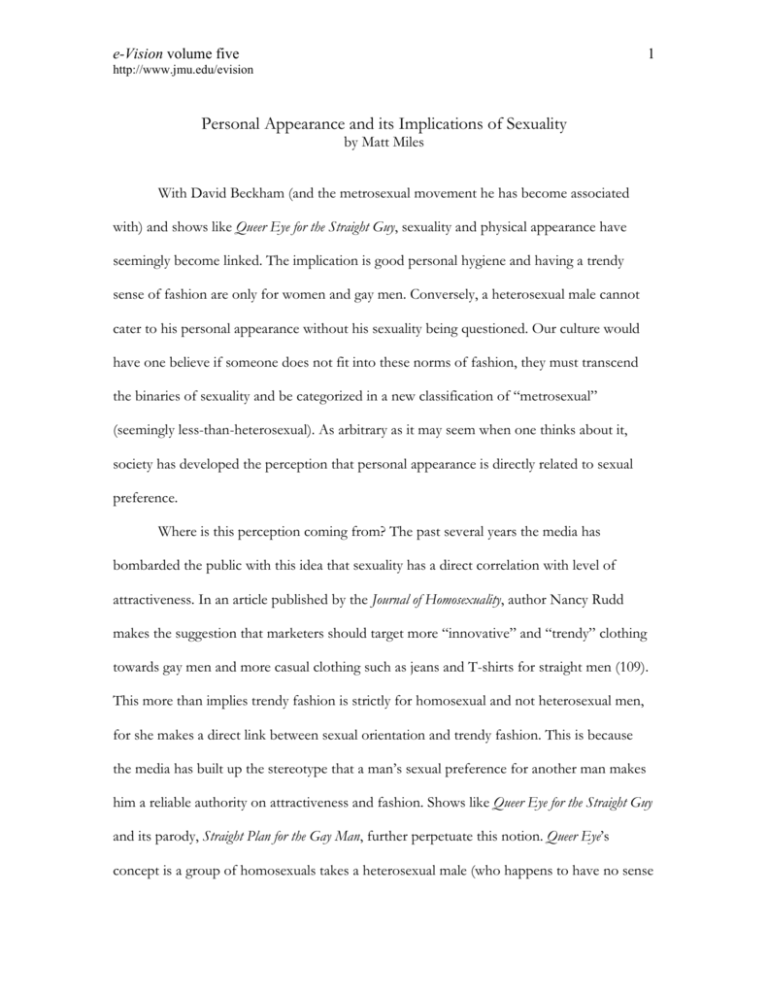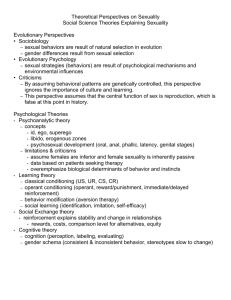
e-Vision volume five
1
http://www.jmu.edu/evision
Personal Appearance and its Implications of Sexuality
by Matt Miles
With David Beckham (and the metrosexual movement he has become associated
with) and shows like Queer Eye for the Straight Guy, sexuality and physical appearance have
seemingly become linked. The implication is good personal hygiene and having a trendy
sense of fashion are only for women and gay men. Conversely, a heterosexual male cannot
cater to his personal appearance without his sexuality being questioned. Our culture would
have one believe if someone does not fit into these norms of fashion, they must transcend
the binaries of sexuality and be categorized in a new classification of “metrosexual”
(seemingly less-than-heterosexual). As arbitrary as it may seem when one thinks about it,
society has developed the perception that personal appearance is directly related to sexual
preference.
Where is this perception coming from? The past several years the media has
bombarded the public with this idea that sexuality has a direct correlation with level of
attractiveness. In an article published by the Journal of Homosexuality, author Nancy Rudd
makes the suggestion that marketers should target more “innovative” and “trendy” clothing
towards gay men and more casual clothing such as jeans and T-shirts for straight men (109).
This more than implies trendy fashion is strictly for homosexual and not heterosexual men,
for she makes a direct link between sexual orientation and trendy fashion. This is because
the media has built up the stereotype that a man’s sexual preference for another man makes
him a reliable authority on attractiveness and fashion. Shows like Queer Eye for the Straight Guy
and its parody, Straight Plan for the Gay Man, further perpetuate this notion. Queer Eye’s
concept is a group of homosexuals takes a heterosexual male (who happens to have no sense
e-Vision volume five
2
http://www.jmu.edu/evision
of hygiene or fashion sense) and imparts their “natural” sense of style on him. The
implication of this show is a homosexual male has some type of natural knack for being
attractive whereas a heterosexual male is seemingly less attractive. The show is not titled
Fashionable Eye for the Unfashionable Guy. Indeed, the creators of the show felt it necessary to
link a show about improving appearance with sexuality. The public accepts this relationship
without hesitation and, in fact, glorifies the bi-product of the relation between the
fashionable homosexual and his heterosexual subject—the metrosexual.
The term “metrosexual” was coined in 1994 by English journalist Mark Simpson and
is defined as, “a dandyish narcissist in love with not only himself, but his urban lifestyle; a
straight man who is in touch with his feminine side,” or as another article put it, “a straight
man who styles his hair using three different products” (“Today’s Metrosexual” 45;
Simspon). Since then, this term has been judged the “most overused word” by Lake Superior
State University’s annual “List of Words Banished from Queen’s English” (Penttila). Despite
the fact most definitions of the term “metrosexual” deal primarily with aspects of
appearance, the term has undoubtedly become linked with sexuality. The obvious indication
is the root “sexual,” which refers explicitly to sexuality and sexual preference. In an article
about famed metrosexual David Beckham, questioning of the athlete’s heterosexuality comes
up quite often. Finally, the author professes, “(he) is not a heterosexual after all. No . . . the
captain of the England football squad is actually a screaming, shrieking, flaming, freaking
metrosexual” (Simpson). This quote perfectly illustrates how Beckham is thought to be lessthan-heterosexual due to his appearance. The author actually states he cannot be a
heterosexual because he is well dressed and manicured. In another interview posted on
ESPN.com in which TV personality Mike Greenberg (self-described metrosexual) admits he
owns and uses Vitamin C facial cleanser and Kiss My Face lotion, he responds, “Yes, I’m
e-Vision volume five
3
http://www.jmu.edu/evision
practically a woman. I’m as close to being a woman as you can possibly get” (Buckheit).
Greenberg not only demotes his own sexuality but his gender, as well, based solely on
several things he does for his own personal hygiene. Both these examples associate men’s
appearance with feminine or less-than-heterosexual male lifestyles. For both men, their
sexual preference does not define their sexuality; their appearance does.
The stereotype is not based solely on a man’s overall appearance. However,
judgments on a man’s sexuality are being made based on relatively minor things he might do
for his appearance or hygiene. An example of this is the new popular trend of the
“metrosexual quiz” that can be found in numerous forms throughout the World Wide Web.
In these quizzes, the user answers questions such as, “Have you ever tweezed, waxed or
trimmed your eyebrows?” The correct answer (for being a metrosexual) is listed as, “Yes,
frequently. I firmly believe eyebrows should be two distinct entities,” whereas the answer for
being completely heterosexual (that is, unconcerned with physical appearance) is, “No,
Never” (“Are You Metrosexual?”). According to this particular quiz, if a man is guilty of
grooming his eyebrows, he loses some of his heterosexuality. Other common questions in
this and similar quizzes cover everything from how much a guy spends on a hair cut to what
type of underwear he wears and what type of soap and shampoo he uses. The user has a list
of options to choose from and, after answering several of these questions, can be rated on
his level of metrosexuality. The rating systems usually go from something along the lines of
“manly man,” (being the most heterosexual) to some sort of metrosexual (being fashionable
and slightly straight), and in some cases, if the person is too into self-care, some level of
homosexual. If a man prefers more expensive haircuts and soaps, he is either homosexual or
metrosexual, but certainly not heterosexual. Quizzes like these make the claim that by
e-Vision volume five
4
http://www.jmu.edu/evision
judging a man through how many shoes he owns or how many types of hair gels he uses,
they can dictate to the user what type of sexual preference he has.
These examples of the media’s bias have an impact on people’s perceptions. In an
article published in Psychology of Women Quarterly about studies regarding personality traits of
physically androgynous people and others’ perceptions of their sexuality, Laura Madison
concludes that people do, in fact, link physical appearance with aspects of a person’s
psychological characteristics. She goes on to state this link is especially strong between men
with more feminine characteristics (manicured nails, well-styled hair) and homosexuality
(149). In Marti Yarbrough’s article, “The Metrosexual Male: What Sisters Really Think of
Them,” women, in reference to their opinions of metrosexual men, say “I may question his
sexual preference,” and “[t]hey dress nice, smell good and are usually good eye candy, but
they present a lot of questions. Like, is he borderline gay or bisexual?” (Yarbrough 34, 36).
For these women, questions of sexual orientation are immediately evoked by a man who is
well-dressed and has a pleasant smell. These studies and interviews illustrate how people’s
perceptions of appearance and sexuality have become linked.
Society has developed a bias that directly links a man’s appearance with his sexual
preference. If a man uses self-care products and dresses fashionably, he is considered less
heterosexual than a man who does not take care of either his physical appearance or
personal hygiene. It has become socially acceptable to commit the fallacy of generalizing and
stereotyping straight men as being less attractive than men who are homosexual. And if a
straight man does happen to have some fashion sense and takes care of his body, the term
“heterosexual” does not apply. Society has developed a new classification to fit this type of
person, “metrosexual,” to indicate his seemingly lower level of heterosexuality. The media
has caused and perpetrates this stereotype through shows like Queer Eye for the Straight Guy
e-Vision volume five
5
http://www.jmu.edu/evision
and many other types of articles and internet sources. In the politically correct society we live
in, usually making a personal judgment about someone’s lifestyle based solely on his
appearance is frowned upon. However, this is an example where it has become acceptable to
make such a stereotype. Shamefully, we live in a society where a heterosexual male who takes
care of his personal appearance is scrutinized by the public eye.
e-Vision volume five
6
http://www.jmu.edu/evision
Works Cited
“Are you Metrosexual?” Sportsnation. 12 Sept. 2004 <http://proxy.espn.go.com/chat/
sportsnation/quiz?event_id=418>.
Buckheit, Mary . “Are Mike and Mike Metrosexuals?” Espn Page 2. 11 Nov. 2004. 12 Sept.
2004 <http://sports.espn.go.com/page2/s/030922Metrogreenygolic.html>.
Madison, Laura . “Inferences Regarding the Personality Traits and Sexual Orientation of
Physically Androgynous People.” Psychology of Women Quarterly 24.2 (2000): 148-161.
Penttila, Chris. “In vain: what does the future hold for the once-hot metrosexual?”
Entrepreneur 32.7 (2004): 24. Expanded Academic ASAP. Carrier Library, James
Madison University. 12 Sept. 2004 < http://web2.infotrac.galegroup.com>.
Rudd, Nancy A. “Appearance and self-presentation research in gay consumer cultures: issues
and impact.” Journal of Homosexuality 31.1 (1996): 109-134.
Simpson, Mark. “Meet the Metrosexual.” Salon 22 Jan. 2002. 12 Sept. 2004
<http://www.salon.com/ent/feature/2002/7/23/metrosexual>.
“Today's Metrosexual.” Global Cosmetic Industry 172 (2004): 45.
Yarbrough, Marti. “The Metrosexual Male:What Sisters Really Thing of Them.”
Jet 105.8 (2004): 34-38.
e-Vision essays copyright © 2005. All rights revert to individual authors.
All authors have granted permission for use in instructional purposes only.











